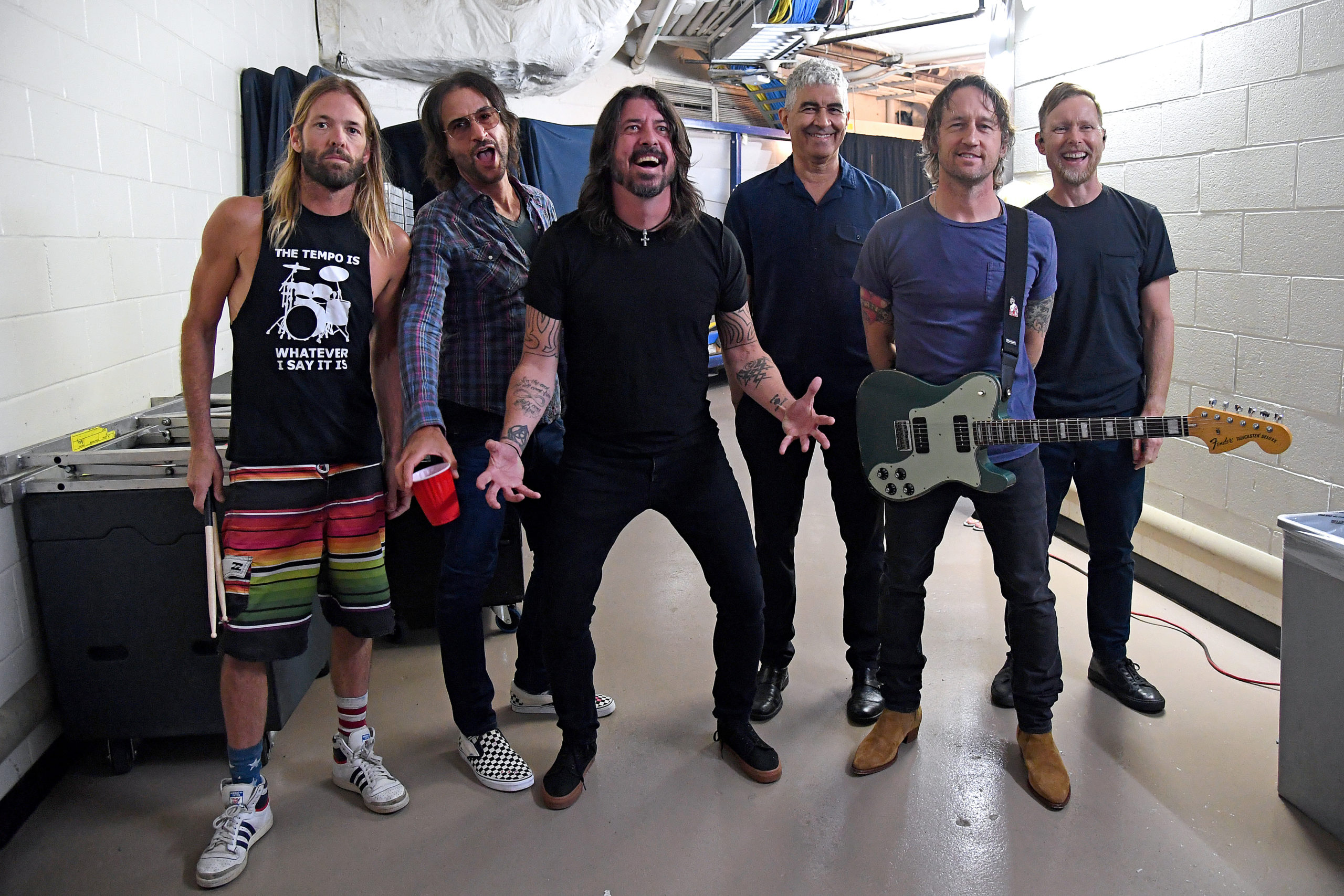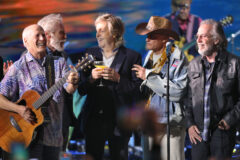Since 1995, Dave Grohl and the Foo Fighters have reigned as one of the most commercially successful rock bands in the world, but the project’s auspicious beginnings belie its enduring popularity. After all, Grohl created Foo Fighters alone in Seattle following Kurt Cobain’s April 1994 suicide, at a time when most Nirvana fans had no idea he knew how to play guitar and probably just expected him to join some other established band as its next drummer.
Ever since, the Foos have released 11 studio albums (including two No. 1s on the Billboard 200 and seven top 10s) rooted in loud, guitar-heavy rock’n’roll, with just enough musical variety to keep things interesting both for themselves and their fans. This steadfast consistency has come in spite of numerous lineup changes and, most recently, the sudden death of drummer Taylor Hawkins in March 2022, which is at the heart of the Foos’ 2023 album, But Here We Are.
Below, SPIN surveys the band’s rich discography to determine where But Here We Are fits alongside favorites such as its 1995 self-titled debut and 2005’s half-loud, half-soft In Your Honor.
11. Concrete and Gold (2017)
As he approached 50, Grohl could still scream with the best of them. Unfortunately, that’s one of the few noteworthy aspects of the band’s first album with producer Greg Kurstin, whose pop sensibilities also seemed out of place on its follow-up, Medicine at Midnight (he did a remarkable job on But Here We Are two years later). The Foos clearly want to turn up the volume with songs such as the punishing, metal-leaning “Run” and the elastic, Zeppelin-y “La Dee Da,” but the material itself is a letdown. “The Sky Is a Neighborhood” skirts waaaaay too close to mainstream dullards such as Imagine Dragons, and special guests such as Justin Timberlake (?!?), a guy from Boyz II Men, and their pal Paul McCartney (playing drums on the Hawkins-sung “Sunday Rain”) threaten to overshadow the band at nearly every turn.
Buy Concrete and Gold on Amazon
10. Medicine at Midnight (2021)
Understandably eager to experiment a bit as their band celebrated its quarter-century anniversary, the Foos trotted out too many ill-fitting ‘80s Duran Duran- and David Bowie-ish grooves (the title track, “Shame Shame”) and backing vocalists (the “na-na-na’s” on opener “Making a Fire” may be the most unwelcome sounds in their entire catalog) on their inconsistent final album with Hawkins. “No Son of Mine” kicks up a decent racket and “Holding Poison” is a wonderful showcase for Hawkins’ versatility in spite of a guitar melody that recalls the Knack, but “Chasing Birds” is the closest the Foos have ever come to lite-rock, and the galloping “Love Dies Young” is a needless attempt at Killers-style drama.
Buy Medicine at Midnight on Amazon
9. Sonic Highways (2014)
The “concept” of a concept album can often be more interesting than the album itself, a conundrum the Foos never quite transcend on this overlong accompaniment to an HBO documentary series of the same name. The band recorded one track in eight different cities, pooling influences and guests from Chicago underground rock, Washington, D.C. punk and hardcore, slick Nashville country, and horn-forward New Orleans jazz. If you ever needed to hear Grohl duet with Death Cab for Cutie’s Ben Gibbard, that’s here too (“Subterranean”). Overall, Sonic Highways is mostly fun enough to warrant repeat listens, particularly thanks to songs such as the Joe Walsh-assisted banger “Outside” and “The Feast and the Famine,” which joyously nicks a couple of Fugazi riffs on its way to a big, strutting chorus.
8. In Your Honor (2005)
That old trope about how every classic rock double LP would be better off condensed into a single disc? It’s largely true on this half-electric, half-acoustic affair, with each style siloed together in 10-song blocks. The rock numbers are all high-energy but sound a lot like earlier and often better Foos material, from the lighter-waving “Best of You” and fist-pumping “DOA” (“no one’s getting out of here alive this time,” Grohl bellows) to the urgent “No Way Back” and the four-to-the-floor rave-up “The Last Song.” Zeppelin’s John Paul Jones, Queens of the Stone Age’s Josh Homme, and Norah Jones help enliven the acoustic cuts, highlighted by “Friend of a Friend,” which Grohl wrote in 1990 about his early impressions of his time in Nirvana, and “Cold Day in the Sun,” a breezy, Replacements-ish number featuring Hawkins’ best lead vocal on a Foos album.
7. One by One (2002)
The Foos graduated to arena headliner status with the Raymond Pettibon-designed One by One, which arrived on the heels of Grohl’s high-profile guest turns on Tenacious D’s 2001 self-titled debut and Queens of the Stone Age’s star-making Songs for the Deaf. With guitarist Chris Shiflett firmly entrenched in the lineup, the thrill of rocking the hell out with good pals clearly carries over onto the ferocious “All My Life,” the oblong, machine-gun riffage of “Low,” and the sprightly, aptly named “Overdrive.” “Times Like These” is another stadium anthem in the vein of “Everlong” and “My Hero,” and its top five success on both the Mainstream and Alternative charts gave the Foos a much-needed crossover hit. A deluxe edition of the album adds amusing covers such as the Ramones’ “Danny Says” (sung by Shiflett) and Joe Walsh’s 1981 hit “Life of Illusion” (with vocals by Hawkins).
6. Echoes, Silence, Patience & Grace (2007)
With Gil Norton back behind the boards for the first time in a decade, Echoes is an outgrowth of the Foos’ 2006 acoustic tour, which found them fully exploring the melodic possibilities previously hidden in their material. As such, the album shifts from fingerpicked acoustic guitar intros to speaker-shredding rock riffs in a matter of seconds, with the explosive “The Pretender” and “Erase/Replace” front-loading the tracklist. More intriguing are “Ballad of the Beaconsfield Miners” (an old-fashioned instrumental guitar duet with Kaki King) and the Freddie Mercury homage “Home,” which closes the album with visions of a wax-encrusted candelabra atop the grand piano. Grohl is also surprisingly transparent with his feelings on songs such as the acoustic “Stranger Things Have Happened,” written about his wife Jordyn, while other tracks reflect the birth of his daughter Violet and his evolution as a husband and parent. Left-field references to Band on the Run-era Paul McCartney, the Eagles, and even ‘70s soft-rockers Bread fit in just fine before they became a smidge too frequent down the road.
5. Wasting Light (2011)
Recorded in Grohl’s Encino garage with Nevermind producer Butch Vig, Wasting Light is the hardest-rocking Foos album of the 2010s thanks to rifftastic gems such as “Rope,” “Arlandria,” “Back & Forth,” and “White Limo,” the most badass, demented song the band had released since The Colour and the Shape. The inclusion of Hüsker Dü/Sugar frontman Bob Mould on the tense “Dear Rosemary” is a nice nod to Grohl’s underground rock roots, while former Nirvana bandmate Krist Novoselic’s deep, dirty bass tone is immediately apparent on the penultimate song, “I Should Have Known.” Wasting Light also spawned two more arena roof-raisers in “These Days” and “Walk,” proving Grohl could still more than capably satisfy the diverse tastes of the Foos’ ever-growing audience at this stage of his career.
4. There Is Nothing Left To Lose (1999)
With its distended bass and pounding drums, the first 29 seconds of opener “Stacked Actors” trigger Ghosts of Nirvana Past before they’re subverted into a hushed verse. The song quickly picks up steam again, but this “to rock or not rock?” dichotomy is present throughout the Foos’ third album, which at the time raised eyebrows for its Cheap Trick and Peter Frampton references but has aged well in the two-plus decades since. With Hawkins behind the drum kit for the first time, the ultra-hooky power pop of “Breakout” and the “write a song where the verses and choruses use the same chord progression” exercise “Learn To Fly” were instant live staples, and “Generator” is arguably the catchiest Foos single never to become a hit. You can also hear the band fidgeting with where to go next: more subtle numbers such as “Next Year” and “Ain’t It the Life” (replete with country twang) presage the acoustic experiments of future albums, while the soothing, delay-drenched “Aurora” points toward a day when Grohl doesn’t have to exclusively scream and shout at his listeners.
Buy There is Nothing Left to Lose on Amazon
3. But Here We Are (2023)
A masterful tribute to both Hawkins and Grohl’s ever-supportive mom Virginia, But Here We Are is the band’s most satisfying and musically interesting album in a very long time. Although he’s back on drums for the first time since In Your Honor, Grohl is in particularly excellent form as a singer and lyricist, capturing the nuances of grief, love, and perseverance with narratives told from perspectives far deeper just his own. “The Teacher” is Foo Fighters’ “Stairway to Heaven”: 10 minutes of cathartic, heart-wrenching rock’n’roll during which Grohl tries to find a hopeful path forward from despair. Just as revelatory are the dreamy shoegaze of “Show Me How” (a duet between Grohl and his teenage daughter Violet) and the righteous, REO Speedwagon-ish “Beyond Me,” which may find you reaching for your nearest loved one and never letting go. Have some Kleenex handy — you’re going to need it.
2. The Colour and the Shape (1997)
Grohl had to find a band to play his songs following the release of the Foos’ 1995 debut, and he found a ready-to-go rhythm section in the form of bassist Nate Mendel and drummer William Goldsmith, whose cult-favorite Seattle band Sunny Day Real Estate had just broken up (for the first of many times). Nirvana touring guitarist Pat Smear also helped bridge the gap from stage to studio, and several songs, including the superlative rockers “Enough Space” and “My Poor Brain,” benefit from having been road-tested in clubs throughout 1996. There aren’t a ton of appreciable musical differences here compared to Foo Fighters, but “Everlong” and “My Hero” find Grohl tapping into a more universal rock’n’roll vein which would serve him very well in years to come (it’s no wonder they became two of the band’s biggest hits). However, personal difficulties between Grohl and Goldsmith led to the latter’s acrimonious departure and Grohl re-recording nearly all of his drum parts, beginning a multi-year period of lineup instability that stalled the Foos’ momentum in escaping Nirvana’s long shadow.
Buy The Colour and the Shape on Amazon
1. Foo Fighters (1995)
It’s an origin story straight out of rock’n’roll myth: Grohl, alone with producer Barrett Jones in a tiny Seattle studio, baring his soul after Kurt Cobain’s death as tape rolled on material he wasn’t sure anybody outside of the Pacific Northwest would ever even hear. These 12 songs are almost comically lo-fi, with Grohl playing every instrument and putting his own often distorted vocals front and center for the first time. He needn’t have worried that nobody would care, as rock-starved fans quickly clamored for the pummeling riffs and screaming rants of “Wattershed,” “Good Grief,” and “Weenie Beenie,” as well as jovial, less confrontational detours such as “For All the Cows” and “Big Me” (and its all-time great video). You could drive yourself batty parsing the lyrics for references to Cobain’s death and/or Courtney Love’s perpetually erratic behavior (the rhetorical question “how could it be / I’m the only one who sees / your rehearsed insanity?,” from “I’ll Stick Around” could be about either or none of them), but you’d be missing the point. Indeed, Grohl had been waiting a lifetime for the chance to record his own material, and he’d spend the rest of his career trying to top this singular achievement in sonic transcendence.
If you purchase an independently reviewed product or service through a link on our website, SPIN may receive an affiliate commission.





